While many in the UK are enjoying the recent sunshine and warm temperatures, spare a thought for those working in environments where the heat can be unbearable. Heatstroke is a more common occurrence than many people might assume and while there are ways a means of mitigating the impact, it can be fatal in some situations. Many people will also be surprised to learn there is no legally defined minimum or maximum temperature for the workplace.
So, what are the rights of employees with regards to working practices and the temperatures in which they work to avoid heatstroke?
What is heatstroke?
Heatstroke is a potentially fatal heat-related disorder in which the body is unable to control its temperature after the natural sweating mechanism fails. Many of us fail to realise how the simple action of sweating helps to regulate the body’s temperature and avoid issues such as heatstroke (aka heat stress). When a person is suffering from heatstroke their body temperature can rise to more than 40°C within just 10 to 15 minutes. Compare this to the natural body temperature of just 37°C.
Heat exhaustion is often a precursor to full-blown heatstroke with symptoms such as:-
- Headaches
- Feeling sick
- Sweating, pale and clammy skin
- Cramps
- Fast pulse
- Fast breathing
- Temperature in excess of 38°C
- Dizziness
- Confusion
- Very strong thirst
Many people will have experienced some of these symptoms when working in hot environments. In this scenario there are a number of options such as:-
- Moving to a cool place
- Lying down with your feet slightly raised
- Taking rehydration drinks
- Cold water spray on the skin
- Cold air fan
The key is to take action as soon as heat exhaustion symptoms first emerge which should ensure it does not convert into full-blown heatstroke. The simple actions detailed above should begin to bring down the individual’s core body temperature within 30 minutes. If there is no improvement and they are not feeling better within this timescale it may have developed into full-blown heatstroke.
Symptoms of heatstroke include:-
- Dry/hot feeling
- Excessive sweating despite not looking too hot
- Core body temperature rises above 40°C
- Rapid/shortness of breath
- Confusion
- Loss of consciousness
- Experience fits/seizures
- Unresponsive
It will surprise many people to learn how quickly heat exhaustion can develop into heatstroke which in itself is potentially fatal and can also lead to other medical conditions.
Preventing heat exhaustion/heatstroke in the workplace
Under the Health and Safety at Work Act 1974 all employers have a legal obligation regarding the health and well-being of their employees (and visitors to their premises). While we tend to focus on the more common injuries in the workplace, heatstroke and heat-related conditions are becoming more common. So the simple actions that employers can take to prevent heat exhaustion/heatstroke in the workplace include:-
- Use air-conditioning or cooling fans
- Ensure there is sufficient ventilation
- Provide the appropriate work breaks
- Ensure equipment is regularly maintained (avoiding the release of excessive heat)
- Provide the appropriate light/loose clothing
- Supply the appropriate safety clothing
There is also a need to ensure that the correct medical equipment and quasi-qualified medical personnel are available as and when required. Many workplaces will have designated medical personnel who will normally have received relatively basic medical training. We are not talking about in depth medical training but a simple ability to spot potential problems and carry out simple tasks to reduce the risks.
In what working environments might heat-related issues occur?
At this point it is worth noting that while the vast majority of heat exhaustion/heatstroke will occur during the summer months, there are working environments that are continually hot no matter what the outside climate. Some of the more common environments that attract heat-related issues include:-
- Heavy labour intensive workplaces
- Working in enclosed environments
- Heavy physical activity under a beating sun
- Transportation of multiple employees in hot conditions
- Offices without air-conditioning
- Extended use of full body safety clothing
- Working with large machinery which can overheat
- Working in environments with limited/no ventilation
The first reaction of the human body is to sweat when hot and, as we touched on above, this is the natural cooling mechanism. However, if you are sweating in an intensely hot environment, or under the baking sun, this can have limited impact and evolve into heat exhaustion and potentially heatstroke.
Regular training
We have all been at health and safety training programs which seem like simple box ticking exercises. Where would we ever use this advice? Is it really that simple? Can working in excess heat really prove fatal? In many ways one of the greatest challenges when educating employers and employees about heat exhaustion and heat stroke is ignorance. We automatically assume that when the heat gets too much that individuals will simply withdraw into a cool environment, take precautionary action and that will be the end of the situation. However, it is not really as simple as that.
It is therefore important to carryout regular training for all employees so they can:-
- Spot the early signs of heat-related issues
- Take the necessary preventative action
- Alert appointed medical personnel
- Call the emergency services if required
Taking preventative action could be something as simple as moving into a cooler environment, administering fluids and circulating cold air. The main problem here is when the developing medical condition is not recognised until it is too late. Heat exhaustion is very different from heatstroke and the real problems occur when heatstroke begins to take hold. At this stage it can prove very difficult to lower the body’s core temperature using traditional methods. In the majority of cases emergency medical attention will be required.
It is also very important to remove someone suffering from even mild heat exhaustion from the working environment as soon as possible. Dizziness and confusion are two of the initial symptoms associated with heat exhaustion. As a consequence, it is not difficult to see the potential dangers of those showing even mild dizziness/confusion using potentially dangerous machinery.
Examples of heat exhaustion personal injury claims
There are many different scenarios where heat exhaustion/heatstroke has occurred leading to personal injury claims. Over the years we have seen a number of common scenarios emerging such as:-
Heatstroke on military manoeuvres
Many people may be surprised to learn that even the military have a legal obligation, along the lines of any normal employer, to ensure the well-being of their employees. Unfortunately, the military has a reputation for pushing soldiers to the limit to make them “battle hardened” and ready for the challenges ahead. However, we have seen a number of military personnel suffering life changing heat exhaustion/heatstroke as a consequence of negligence on behalf of the military.
If we look at the army, there is now strict guidance on avoiding heat injuries as a consequence of the death of Jason Smith in Iraq in 2003. While lessons were learnt, many military personnel literally pushed to the edge and suffering medical trauma, have found it extremely difficult to pursue personal injury claims. The common defence has been to suggest that the claimant had an underlying medical condition and the excess heat of the military exercises were simply a contributing factor. Slowly but surely greater protection is being afforded to military personnel and those who do suffer an injury in the military as a consequence of negligence are now more likely to receive compensation.
Summer music concerts
The UK seems to attract the extremes when it comes to weather conditions during the summer concert season. We have seen the mud from T in the Park to the basking hot sun of Glastonbury with many more events experiencing similar climate variations. The basking sun, alcoholic beverages, dehydration and the natural build up of heat within large crowds can on occasion prove dangerous, if not fatal. It is therefore the obligation of concert organisers to ensure:-
- The relevant medical attention is on hand
- Emergency exits are visible
- Safety channels that allow personnel prompt access to crowded areas
- Health and safety guidance is offered to all attendees
- Stewards are trained to recognise potential problems and take action
While there is an obvious responsibility on concert attendees to look after themselves and take the appropriate weather-related action, there is also a responsibility on concert organisers. In many ways the best form of defence is preventative action which would reduce the number of heat-related medical issues.
Proving negligence for heatstroke
If you suffered heat exhaustion/heatstroke which brought on physical or emotional distress, and potential life changing injuries, you may well have a claim for compensation – if you can prove liability. Thankfully, over the years we have seen the development of guidance and legal regulations covering this area. That is not to say that all instances of heat exhaustion/heatstroke will involve a degree of negligence. If an employer/event organiser was able to show that preventative action was taken, the relevant trained personnel were in attendance and they did all they could, then it may be difficult to prove negligence.
The best way to avoid any form of heat exhaustion/heatstroke is to be prepared, take regular breaks, ensure that you are hydrated at all times and take action to reduce your core body temperature. Unfortunately, many of those who suffer heatstroke may not recognise the symptoms themselves until it is potentially too late.



